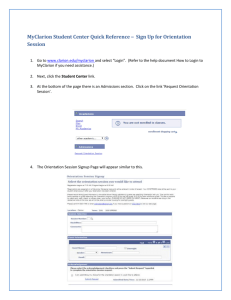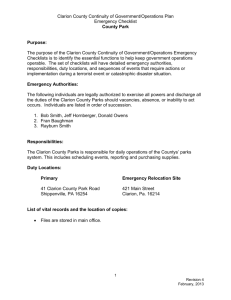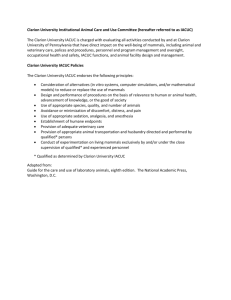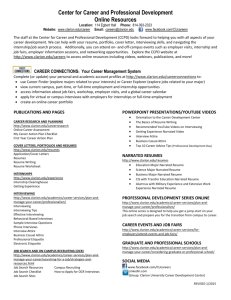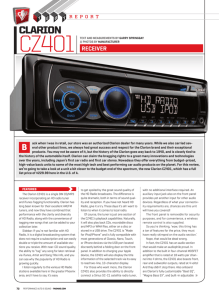AT&T RECOGNIZES THE IMPORTANCE OF CAPTURING THE
advertisement
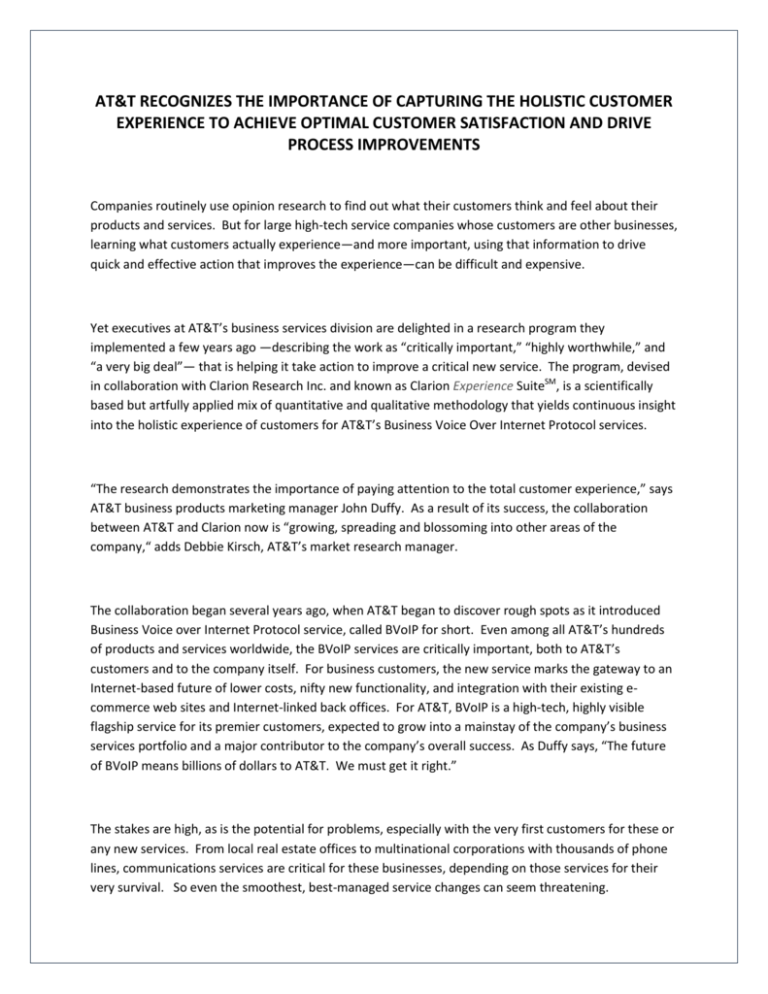
AT&T RECOGNIZES THE IMPORTANCE OF CAPTURING THE HOLISTIC CUSTOMER EXPERIENCE TO ACHIEVE OPTIMAL CUSTOMER SATISFACTION AND DRIVE PROCESS IMPROVEMENTS Companies routinely use opinion research to find out what their customers think and feel about their products and services. But for large high-tech service companies whose customers are other businesses, learning what customers actually experience—and more important, using that information to drive quick and effective action that improves the experience—can be difficult and expensive. Yet executives at AT&T’s business services division are delighted in a research program they implemented a few years ago —describing the work as “critically important,” “highly worthwhile,” and “a very big deal”— that is helping it take action to improve a critical new service. The program, devised in collaboration with Clarion Research Inc. and known as Clarion Experience SuiteSM, is a scientifically based but artfully applied mix of quantitative and qualitative methodology that yields continuous insight into the holistic experience of customers for AT&T’s Business Voice Over Internet Protocol services. “The research demonstrates the importance of paying attention to the total customer experience,” says AT&T business products marketing manager John Duffy. As a result of its success, the collaboration between AT&T and Clarion now is “growing, spreading and blossoming into other areas of the company,“ adds Debbie Kirsch, AT&T’s market research manager. The collaboration began several years ago, when AT&T began to discover rough spots as it introduced Business Voice over Internet Protocol service, called BVoIP for short. Even among all AT&T’s hundreds of products and services worldwide, the BVoIP services are critically important, both to AT&T’s customers and to the company itself. For business customers, the new service marks the gateway to an Internet-based future of lower costs, nifty new functionality, and integration with their existing ecommerce web sites and Internet-linked back offices. For AT&T, BVoIP is a high-tech, highly visible flagship service for its premier customers, expected to grow into a mainstay of the company’s business services portfolio and a major contributor to the company’s overall success. As Duffy says, “The future of BVoIP means billions of dollars to AT&T. We must get it right.” The stakes are high, as is the potential for problems, especially with the very first customers for these or any new services. From local real estate offices to multinational corporations with thousands of phone lines, communications services are critical for these businesses, depending on those services for their very survival. So even the smoothest, best-managed service changes can seem threatening. Also raising the potential for customer frustration is the variety of internal organizations and external vendors that share responsibility across functional and geographic lines for delivery of AT&T’s new service. Each department not only performs its own function, but also is responsible for smoothly handing off to the next: from research and development to sales, marketing, engineering, provisioning, installation, billing, and customer care. But each handoff, especially when it involves customer “touch points,” multiplies the opportunities for disruption or miscommunication. Shortly after the launch of BVoIP, AT&T’s sales and operations staff began noticing and reporting customer problems, or “pain points.” Facing that reality, the business and functional leaders called together Helen McGrath, AT&T vice president of market insights, and her team of market research specialists to help address these issues. Together they deployed an action plan to measure and assess the customer experience through a formal ongoing market research program. To lead the research program AT&T chose Clarion Research, a market research firm with extensive experience in complex, high-tech businesses from healthcare and education to communications. Clarion’s team of research experts operates from the perspective of a consultancy. AT&T selected Clarion Research’s Experience SuiteSM solution for this project. “The goal of Clarion Experience SM Suite is always deliver customer-impacting insights,” says Steve Crane, Clarion’s executive vice president. “We want to understand the contribution each company touch point makes to the total customer experience, so we can provide our clients with the richest, most action-oriented insights.” “The customer experience is not an isolated transaction, but a series of touch points, or ‘moments of truth’—each one an opportunity to delight or possibly disappoint,” says McGrath. “While all touch points affect customer perceptions, driver analyses helped identify that certain ones are highly correlated—closely related—to the customer’s overall loyalty . By focusing our improvement efforts on those key touch points, AT&T has been able maximize the impact of our improvement efforts.” Since implementing this customer experience research program, AT&T has seen improvement in 48 of 54 customer satisfaction metrics it tracks. And 39 of these key measures have improved by 10% or more. In practice, Clarion’s Experience SuiteSM is multi-faceted and begins with conversation. In small groups or one-on-one, an experienced researcher talks directly to customers, building rapport and understanding. This leads to mapping of customer touch points. “We try to view the world through the customer’s eyes,” says Randy Zeese, Clarion’s executive vice president. “We pay attention to the customer’s own language, and we’re alert to potential pain points—things that frustrate or dissatisfy or even delight the customer.” Using insights and customer experiences gained from the ExperienceMap exploratory conversations, AT&T then utilized Clarion’s Experience Trac to develop a standardized, repeatable, empirical customer survey process—a structured set of questions, that can be covered comfortably in about a 30 minute telephone or web-based interview. With strict attention to statistical validity, Clarion aggregates and analyzes the results of multiple interviews, producing a set of ongoing measurements presented in clear charts and graphics. Finally, ExperienceVision brings together multiple AT&T operations teams to discuss and understand the findings. At each step of the AT&T/Clarion collaboration--from the early qualitative research (Clarion Experience Map), to the quantitative data gathering (Clarion Experience Trac), to the discussion and prioritizing of ongoing action (Clarion Experience Vision)--the process moved toward actions that ultimately resulted in process improvements. “This research program became a rallying point for cross-functional teams to prioritize initiatives aimed at continuously improving the Customer Experience”, according to Shawn Conroy, AT&T’s vice president of product management. In addition to measuring and focusing strategic improvement on customer loyalty through the calculation of their Net Promoter Score®, AT&T also implemented a simple and consistent measure of customer satisfaction (Net Satisfaction Scores) applied across all operational areas – to understand and measure how well the company is performing, from the customer perspective, in a single comparable metric. By using the Net Promoter Score® algorithm as the core metric, AT&T is able to measure its Net Satisfaction Score performance on each functional area on the customer journey. One Clarion insight was “like a smack in the face,” recalls AT&T’s Duffy. Clarion’s initial analyses had revealed customer dissatisfaction around an aspect of the billing experience. With further investigation, the research revealed the problem. “Without doing this kind of customer research, we would have known a little bit, but we would have been blind about the real issue,” says Duffy. With the benefit of Clarion’s insight, he says, “We were able to figure out what had changed, legitimately and honestly. That knowledge was totally golden, really useful. Finally we could touch it—tangible evidence of a problem, and a problem that we could and did address.” Another Clarion insight produced “an ‘aha’ moment” for Guil Godoy, AT&T product marketing manager. Clarion had identified as an acute “pain point” customers’ perception that AT&T was taking too long to complete installation of BVoIP service. But, says Godoy, “We saw that there was no correlation between the customer survey answers and the actual time. It was just a scatter pattern.” It turned out the real problem was not slow installations, but a need for more communication between internal departments. “The survey pointed us to the answer, and the actual time to install just wasn’t it. So we were able to eliminate a whole potential problem area,” says Godoy. “That was really a big deal, since it took the heat off an entire organization.” AT&T fixed the problem by retraining the sales team to improve communication. “Research that can be used to drive action is highly worthwhile,” says Bill Higbee, AT&T manager of business product sales and marketing. For AT&T’s introduction of BVoIP, he says, “The complexity of the product solution and sales channels, the involvement of third party vendors, and the need for multiple interfaces within AT&T all make it more difficult to accurately assess customer expectations.” He adds, “As a result of the survey findings, we’ve increased our analysis to understand the differences in results across our sales channels, and the drivers of those differences. The customer experience research has enabled us to continuously improve our sales and marketing functions.” Clarion’s Experience SuiteSM “allows us to walk through the process holistically from end to end with the customer’s eyes, with no agenda except finding out how this is going for the customer,” says Suzette Drouillard, AT&T director of business process management. “As a result, our customers are better off, we are more effective and efficient, and we spend less to provide better quality service and a better customer experience.” She adds, “This type of comprehensive, customer-based research process should be done for each and every strategic product of AT&T.” Even when the results were complex, the researchers at Clarion “were right there to help us position the survey,” says Eric Wedinger, AT&T director of VoIP product marketing. “Clarion was thorough and made the output easy-to-understand.” Wedinger’s group now holds a monthly call to review the latest research results, and they encourage discussion that leads to “drilling down” on issues, and sometimes to new or revised survey questions. “Clarion has been a terrific partner,” says Helen McGrath, AT&T’s vice president of market and competitive assessment. “They can be as quantitative as anyone from engineering or finance, and as probing as investigative journalists. They are very good at spotting trends early, isolating the few things that matter most, making recommendations backed by solid data, and hanging in and contributing to discussions with our management team. Most importantly, we can trust Clarion to stand up and tell us the truth, even if it hurts—and back it up with hard numbers and verbatim comments directly from our customers,” McGrath says. “This customer experience research enables us to continuously improve,” says Eric Wedinger, AT&T’s director of VoIP product marketing. “As a result, we have a better focus on what customers want, what they expect, and whether or not—and where—we are meeting or exceeding customers’ expectations.” “This is ongoing,” he adds. “We can’t kick back.” # # #
